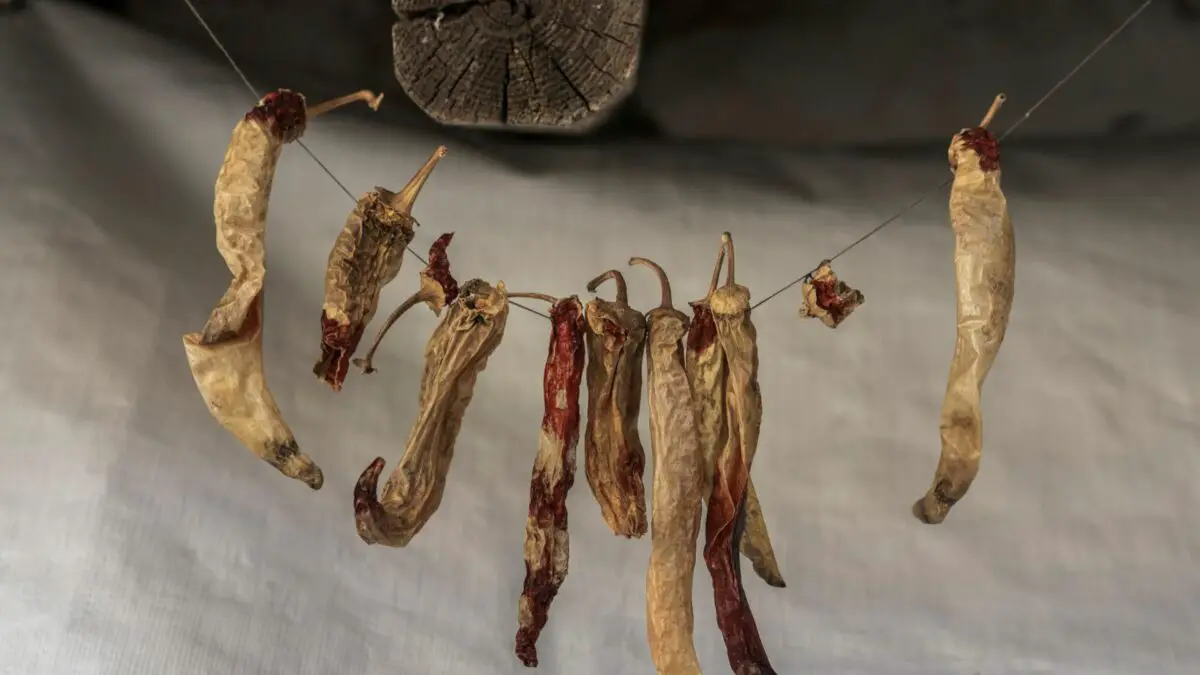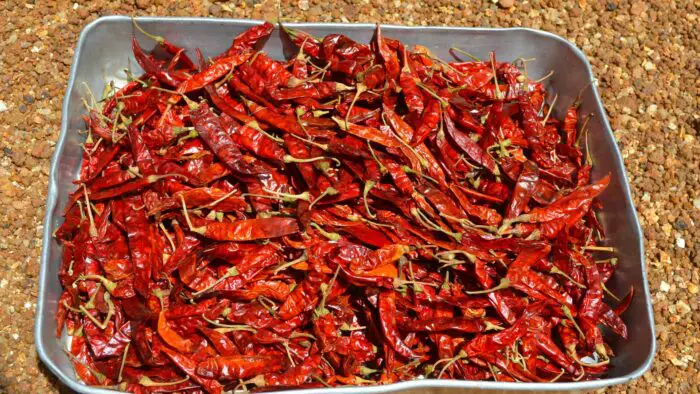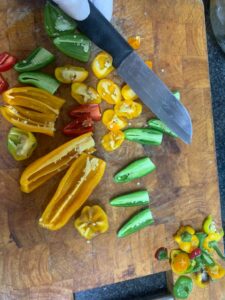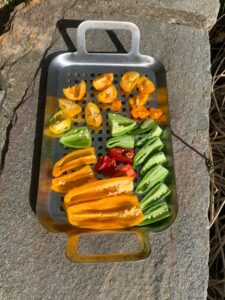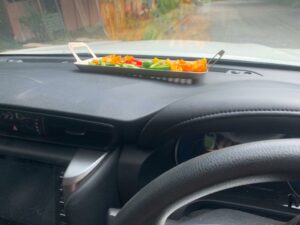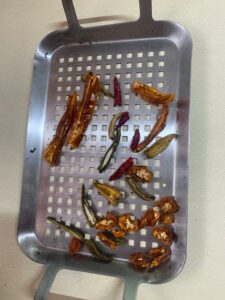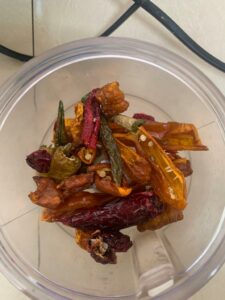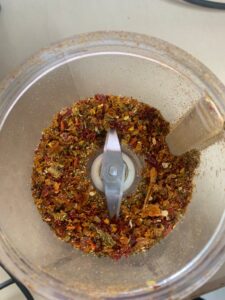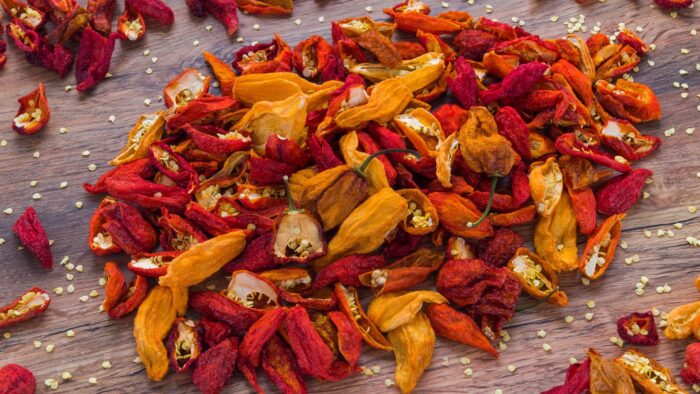Last Updated on February 20, 2023 by Griselda M.
You arrived here because you want to know how to dry chilies in the microwave. I love chilies and need to say that the microwave is not a good option. Let’s have a look at all the options and then at the end have a look at how to dry chilies in the microwave.
When we grow peppers we grow two main types – chili peppers that burn and sweet peppers (green, yellow, orange, red, etc) that do not have any burn. Often people want to know how to dry chilies in the microwave. I personally find this is not the best method. Let’s have a look at why we preserve peppers, and how the best methods to do this work for the different types of pepper.
A Quick Overview of Peppers
Peppers are “berries” with a fleshy exterior and seeds inside. They belong to the genus Capsicum. There are many species and hybrids of species that are available to cultivate. This gives us a nearly limitless range of peppers, from ones that have no heat at all (sweet peppers) to ones that burn the Bedangle out of your mouth and other bits later (chili peppers).
The chili peppers have specifically been in a bit of an arms race over the past few thousand years, with people breeding hotter and hotter peppers. In the past two decades, this has become nearly ridiculous – the heat of a pepper is measured in Scoville units – and the rate of increase in Scoville units is nearly starting to follow Moores Law in recent years.
As we have mentioned, there are many species of pepper in the Capsicum genus. Something really important to understand is that if you plant hot chili peppers near sweet peppers they will cross-pollinate. You will get sweet peppers of doom, and your chilis may be somewhat underwhelming. I grow the peppers in my flower garden, and the chilis in my upper garden, and I keep them 100 yards apart.
Peppers grow well in good compost and manure-rich soil. They like warm weather and long days, and if you get it right, they will reward you with a crazy crop. It is important to give them quite a bit of food, as peppers are heavy feeders – an organic product such as this is good. Peppers also enjoy good mulch.
If you do this right you will get a bumper crop.
What Happens if I Produce More Peppers/Chilis than I Can Eat?
If you have planted 10-20 peppers, and they grow well, you will produce way more than you can understand what to do with. Do not give them away to everybody. There is this really irritating thing gardeners do – they produce more they can eat and give the produce away to lazy people who could not get off their bums and grow plants. This is encouraging laziness.
Swap peppers for things with other people who do something useful with their lives but in no way is it acceptable to give your hard-grown peppers to some fool that goes and spends their time at a gym and cannot give you anything back other than a smile. If you have more than you can trade, and eat, then you need to store your surplus – for yourself.
What to do with Surplus Sweet Peppers?
Drying a sweet pepper is a waste of a pepper. We dry chilies. We make preserves with sweet peppers.
Sweet peppers tend to be really thick and juicy – my favorite method of preserving these is quite simple. I cut them into quarters and allow them to dry in the sun for a few hours. This partially removes moisture. Then you take these and grill them for twenty minutes in the oven so that they are a bit soft and slightly crispy on the edges. Take these and sprinkle a little live vinegar on them – this lowers the pH so that pathogenic bacteria cannot grow on them.
Vinegar contains acetic acid and other organic acids that inhibit the growth of pathogenic bacteria. You can add spices of your choice. I always keep a bit of standard pickling spice mix around. This forms a good base for nearly any pickle and then you can play around adding curry, garlic, and so on. I normally cover my pickles in a layer about two inches thick of virgin olive oil.
A budget oil such as this one works as it is not too expensive or fancy. Fancy, organic expensive oils tend to not have much in the way of antioxidants in them, and then they go rancid – in the case of making oil pickles, you actually want a budget oil, because rancid oil is worse for your health than antioxidants such as TBHQ that are added to budget oils to protect them are. Place the oil pickles in a jar such as this.
The reason I use an opaque jar is to stop sunlight from getting in and making the oil go rancid. You can keep these in a cool dry spot and they will last a few years. You can put oil-pickled peppers on anything – I use them in stir-fries, on roast meat, in stews, and salads, and I make a curried green pepper oil pickle that is really nice on ice cream!! Sometimes, I just go and eat a bottle of these things for the hell of it – straight – just spoon them from the jar! They are that good.
Steps on How to Dry Chili Peppers
Chili pepper plants are evil in their ability to just overproduce. There are only so many fresh chilies we can actually consume without going to the ER.
I grow Ghost Chilis and Chocolate Death Spiral and, as a very experienced chili eater, I can confirm that eating more than one of these chilis per day will probably result in physical harm! They taste great, but there is only so much your body can take. Chili is good to a point. Any more and we need to preserve them.
For hot chili peppers, drying is a very viable option. When I dry chili peppers, I have two methods I use – and these are different from the methods you read in other blogs. Again, my methods are things I do, and use every year, so, trust me – I have not cut and pasted – this works.
Currently, it is not peak chili season where I am, but I managed to find enough to do a demonstration. Here are my pictures.
My Quick Cheat Method
Step 1 – Halve the chilis. Wear gloves. The heat in Chilis is concentrated on the seeds. If you touch these seeds, and that sap gets on your fingers it can cause havoc later if you touch your eyes or inadvertently touch anything on a trip to the bathroom. Be warned. Nothing is worse than doing the chili willy dance or its equivalent if you have the alternative set of genitalia down there. I have actually heard the alternative dance is even worse.
Step 2 – Place the chilis on a stainless steel tray. I use a perforated stainless steel pan that I happen to have, or if I do a larger batch I just use a barbeque grill. If I had to buy something, I would buy this.
Step 3 – Place the chilis in your vehicle so that they are exposed to the sun and heat inside the vehicle. This dries them rapidly – even on overcast days. I just park my car so it faces the sun, and within two days the chilis are dry. If however, you live in an area where the climate is not cooperative (cold) you can place these trays in an oven and set the heat at 120-130°F with the fan running and wedge a cloth in the oven door to keep it a little open. This allows the moisture to escape.
The pictures above show my quick cheat method to make dried peppers – I actually did this over the past three days and am now eating an omelet with these peppers sprinkled on it. And they are HOTTTT.
How to Dry Peppers in the Sun
If you do not have a vehicle to use as per my cheat method above, you can place the trays in the sun. I tend to move them around as the day goes past. During the lockdown, I used this method a lot because we were not allowed to take our vehicles out on certain days, so drying in the sun, and being at home made this easy.
The late fall sun can be quite weak sometimes, but look ahead at the weather forecast and choose a time to process peppers when it will be sunny and windy for a few days. Not so windy that sand is blowing around – this will ruin your peppers, or blow them away – just windy enough to get good air movement. This helps to move the moisture out of the peppers. I find in my area it takes three sunny days to dry peppers enough outdoors that you can bring them indoors to finish off.
Drying Thai Chili Peppers
Thai Chili peppers are not particularly hot chilis being about 50k to 100k Scoville units. The thing that makes Thai cooking really hot is not the quality, but the number of peppers used. For me, these are nice everyday pepper.
The ones I grow are the very long slender types, and I actually find the easiest with these is just to dry them whole! I don’t even bother to cut them. I just leave them on the plant, and they hang like a bright red Christmas tree decoration set. You can harvest them and just put them on a tray on the windowsill. Cutting them up and drying them in your car or oven is unadvisable as they release some evil vapor that will make you sneeze a lot. I just dry them whole.
Alternatively, at the end of the season, snip the pepper plant off at the base and hang the entire plant upside down indoors and the peppers dry on the plant. Once they are bone dry, take them and snip the peppers off and place them on a tray to give a final few days of drying.
How to Dry Habaneros
A Habanero is an exquisite pepper with a delicate taste and a fierce burn. You want to do everything you can to preserve both. This is one of my favorite medium peppers. Habanero powder is a great thing for adding a little zing to any dish that needs a zang. I actually like it in omelets and on a pizza instead of Paprika. Paprika is like alcohol-free beer or wine – there is no logical reason to consume it if you can consume the real thing. Habanero powder is the real thing.
I dry Habaneros using the car window method listed further up, but as a special ending trick, when the peppers are nearly dry, I finish the drying process off in a smoker. I use an old Weber lid over my barbecue and use oak chips on a weak coal bed to make dense oak smoke and this makes the habaneros go brown and so delicious that I now have to take a snack break just thinking about them!!
If you do not have a smoker and have a bit of spare cash lurking around, you will never regret getting something like this as an entry-level smoker, or one of the many fancy ones listed on Amazon. Smoking food just makes it better. I have even smoked honey once and used that to make a reduction.
I just take the dried habaneros and mill them in a coffee grinder and make a powder with this (using a face mask) (and gloves) and then put this in a shaker with quite small holes.
Sun Dried Jalapenos
A Jalapeno is a pretty tame chili – it is a good thing to use to introduce novices to the art of chilis. The main thing about these peppers is that they have a lovely flavor. If you have so many of them that you cannot figure out what to do with them (eg making Jalapeno poppers, stir-frying, eating straight, using them in a salad, etc) then you can dry them. If for some ungodly reason, you were to find a recipe where they want Paprika, you can use Jalapeno powder as a superior substitute. It is a bit tame, but at least has a little discrete bit of goodness, unlike Paprika.
I follow the same method as above for Habaneros, and smoke Jalapenos at the end as well. Do not ever remove the seeds from Jalapenos – if you do this you reduce them to green peppers with no good burn whatsoever. This is a terrible waste of an otherwise slightly acceptable chili. If you find the powder a bit boring and tame you can always blend a bit of habanero into it.
How to Dry Chillies in the Microwave
Ok, so now we get to our core question! To understand this, let’s have a look at what a microwave oven is, and how it works. Microwaves ovens produce microwave radiation – this has a wavelength and because of this, there are warmer and cooler spots in the microwave. Microwaves cause water molecules to vibrate, and this causes a molecular friction effect, that causes the items to get warmer. If you want a lovely explainer of microwaves this video is helpful.
To correct for the fact that microwaves have a wavelength, the oven is equipped with a rotating tray – as the tray rotates, the heating in the tray becomes a bit more even, but it is still not perfect. This is why we find there are always spots in the microwave where things will get a bit warmer than other spots.
As something dries, the amount of water in that thing gets less, and the amount of heat transferred per unit volume of chili increases. Hence what you will find with a microwave is that as something dries out in the microwave, you will find it goes from dry to on fire very quickly. I used to try and dry turnips in the microwave – a turnip is an entirely useless vegetable taste-wise, but it is very good for you. Drying turnips to remove the turnip taste allows you to make turnip powder which is actually nice to use in soups. However, they can catch alight just at the point that they are perfectly dry. The same happens with chilis.
If you do wish to dry chilis in the microwave, I would suggest putting a lot of chilis in the oven, putting the wattage as low as possible – 120W or so, and then checking the chilis every few minutes, and then take these partially dried chilis and put them in the window of your vehicle and allow them to finish in the sun. The Microwave oven is my lowest popular choice for anything that involves drying – I have had too many fires and disasters with these ovens.
How to Dry Peppers With Food Dehydrator
If you are having a problem with air moisture which can prevent your pepper from air drying properly, you can opt for a food dehydrator. A food dehydrator is one easy and fast method of drying your peppers successfully.
- Select your fresh pepper. Bigger pepper should be cut into pieces so they can lose moisture and dry quickly. Smaller pepper of about 1 inch can be dried whole.
- Then set your dehydrator temperature between 135 and 145 degrees Fahrenheit. Your pepper should be well dried around 3 to 12 hours of dehydration depending on the thickness of your peppers. When your peppers become brittle shows they are well dried.
- Storing your dried pepper in a glass jar away from sunlight is a perfect way to preserve your pepper. This way, the color of your pepper is preserved.
In Conclusion – How to Dehydrate Peppers
We have had a look at how to dry chilies in the microwave, and a few better methods to do this. We have seen that drying a sweet pepper – the one that is not hot – is really a waste of pepper. My general advice with peppers is if you can dehydrate chili peppers in the window of your vehicle – and then smoke them a bit, and you will have the best chili to make into powder and use to add magic to each meal. I eat a lot of chilies and enjoy my chili powder a lot. Smoked powdered hot pepper is just one of those things you have to make yourself understand how amazing it is.
COSORI Premium Food Dehydrator
FAQs
FAQs
How do you dry peppers quickly?
There are a lot of ways to dry peppers quickly. It's important to remember that you should use the right technique for your peppers and to store them properly in airtight containers.
Using an oven for this process is a good idea but if you don't have an oven at home, then you can use one of these methods:
- Place the peppers on a wire rack over an open pot or inside another container with a lid and cook them inside the oven at 170 degrees Celsius for 15 minutes
- Place the peppers in a bowl with paper towels or cloth napkins and cover them with plastic wrap
- Place paper towels or cloth napkins on top of another bowl with water in it and place the whole bowl inside your microwave
Can I dry peppers in the oven?
Yes, you can. There are several ways to do this. You can dry peppers on a baking sheet in the oven on the lowest heat setting; simply place the peppers on the baking sheet and let them dry overnight. You could also remove the stem from each pepper and place them individually in a single layer at least 1" apart on a baking sheet, then put that pan in a 250°F oven for about 20 minutes or until they're crispy, turning them often.
Since most of us have never dried peppers before, it may be helpful to know what happens when they start drying. First, they will become brittle and turn golden brown; once they start to crackle and you see tiny black seeds scattered throughout the pepper, it's ready!
How do you dry peppers in the sun?
To dry peppers in the sun, place them on a paper towel or cloth. They need to be in a well-ventilated area with direct sunlight. Keep them out of reach of animals and birds.
Peppers can be dried in the sun if they are placed on a paper towel or cloth and left uncovered for at least 6 hours under direct sunlight. The peppers should also be removed from the ground and placed in another container so that they don't get wet while they're drying.
Can you dry chillies in the microwave?
Yes, you can dry chillies in the microwave. You can dry chillies in the microwave by cooking them with a damp paper towel (without removing the seeds) and then placing them on a plate covered with paper towel, leaving it for at least 15 minutes.
How do you dry whole jalapeno peppers?
The first step in this process is to cut the jalapeno into halves and remove the seeds, which will make it easier to dry them later. Then you'll need to slice the pepper thinly into paper-thin strips. The best way to do this is by using a mandoline slicer or by cutting it with sharp knives.
Once you have cut all your slices, place them on baking sheets lined with parchment paper and lay out your baking sheets for about an hour before drying them in an oven set at 130°F for about until they are completely dried on the outside.

Eunice is a gardener who loves to play in the dirt. She starts her day early in the morning, watering her plants and tending to her garden. She loves the smell of freshly cut grass and the feeling of sunshine on her back as she works. She‘s a master at creating beautiful flower arrangements and can often be found humming a tune as she tends to her plants. When she‘s not gardening, she loves to read books about nature and share her knowledge with others. Eunice loves gardening so much that she‘s even been known to talk to her plants!

